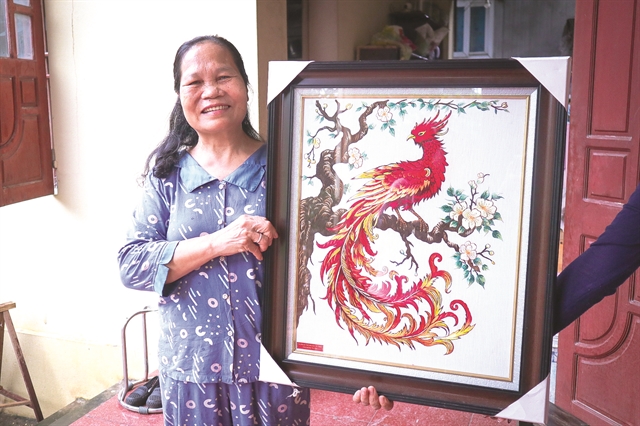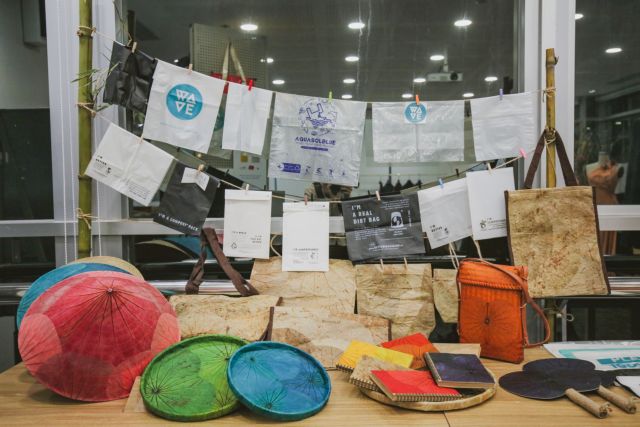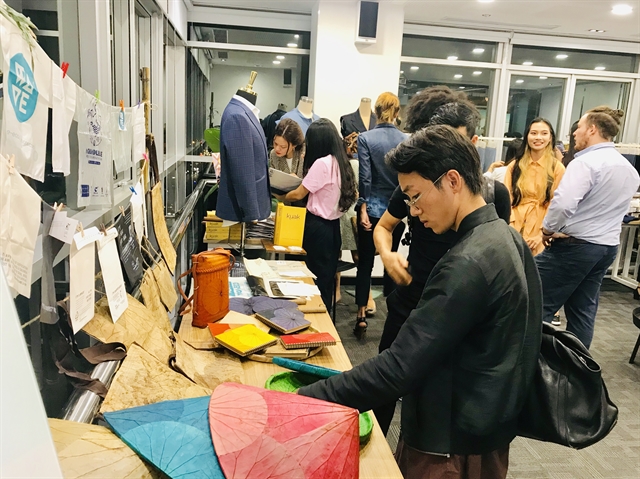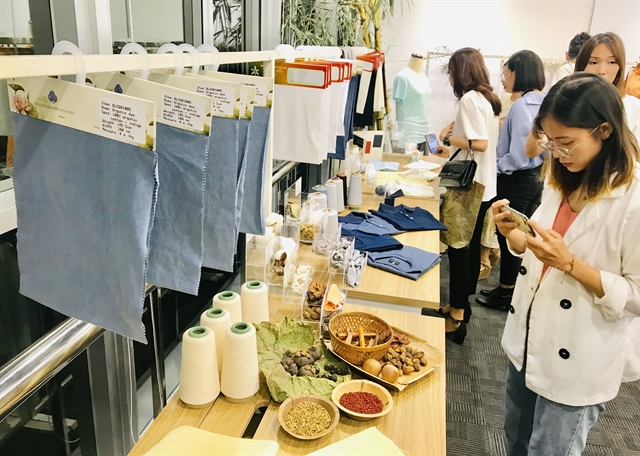 Features
Features

Engagement in sustainability in the fashion industry has deepened as environmental concerns are increasingly important among consumers who are calling for more environmentally friendly practices in the industry, starting from raw materials to end-of-life products. Bồ Xuân Hiệp reports.

|
| Quách Kiến Lân (centre), CEO and founder of GreenYarn Bảo Lân Company, which produces environmentally friendly fabrics, speaks at the recent “Fashion Robs My Future” talk show in HCM City. — VNS Photo Bồ Xuân Hiệp |
Engagement in sustainability in the fashion industry has deepened as environmental concerns are increasingly important among consumers who are calling for more environmentally friendly practices in the industry, starting from raw materials to end-of-life products. Bồ Xuân Hiệp reports.
Bồ Xuân Hiệp
Yeenky Vũ, manager of a Vietnamese joint-stock garment company, often feels she doesn’t have enough clothes and is sometimes unsure about which outfit to choose when going out for an event or meeting friends.
The 39-year-old woman from HCM City was not aware that she had too many clothes, many of which she had not worn even once, until she recently sorted them for donations to people in the flood-hit central region.
“I am so obsessed with fashion that I always want to buy more,” she said. “I don’t even know how much money I have spent buying all my clothes over the years.”
According to the World Bank, 40 per cent of clothing purchased in some countries is never even used.
Vũ Anh Thư, a fashion advisor and CEO and founder of Coco Dressing Room, a platform selling and buying second-hand clothes, said: “We are living in a ‘throwaway’ culture and fashion waste has been increasing. Selling and buying a second-hand clothing product can be an option. It contributes to reducing its environmental impact.”
Fee Gilfeather, a sustainable fashion expert at the British charity group Oxfam, agreed, saying: “Used clothing gives clothes a second life and it slows down the fast-fashion cycle.”
Over the last decade, the concept of fast fashion has revolutionised the fashion industry, and new fashion styles are available almost every day.
Fast fashion is popular due to its affordability, but it comes at a cost. Experts estimate that one cotton T-shirt consumes up to 2,700 litres of water, and one pair of jeans 7,000 litres.
Textile production is estimated to account for 25 per cent of all global carbon emissions by 2050. And washing certain types of clothes discharges a huge amount of plastic into the ocean.
Speaking at a recent talk show titled “Fashion Robs My Future” in HCM City, Đỗ Thị Thanh Huyền, founder and director of the non-profit group Gaia Nature Conservation, said: “The fashion and textile industries are among the 10 most polluted industries in the world.”
"The industry emits more carbon than the aviation and shipping sectors combined. It produces 10 per cent of all humanity’s carbon emissions, is the second-largest consumer of the world’s water supply, and pollutes the oceans with microplastics," she noted.
As consumers worldwide buy more clothes, the growing market for cheap items and new styles is having a negative environmental impact. Fashion production also dries up water sources and pollutes rivers and streams, according to Huyền.
Sustainability trends

|
| Environmentally friendly materials and products in the textiles and fashion industries are on display at an exhibition area held as part of the recent “Fashion Robs My Future” talk show in HCM City. — VNS Photo Bồ Xuân Hiệp |
In recent years, more consumers are becoming aware of the industry’s environmental footprint and have already begun changing their behaviours accordingly.
Dr Phạm Hải Chung, from Hà Nội, said: “As a frequent TV guest speaker, university lecturer and media consultant, I often have to go out to meet people. So I do care about fashion.”
Chung, 37, a lecturer at the School of Journalism and Communications at the Hà Nội-based University of Social Sciences and Humanities, said: “Tailor shops that sell fabrics such as linen and cotton have become my favourite."
“The social and environmental values of a brand matter to me, such as use of eco-friendly materials,” she said.
“A good product is no longer enough to win a consumer’s heart. Consumers want more than just quality. They often look for products and brands that meet their personal values.”
Many consumers have adopted more sustainable behaviours as they are trying to be responsible citizens of the world, and in return, they expect the same from brands, Chung noted.
A recent survey of more than 2,000 UK and German consumers by McKinsey & Company about sustainability in the fashion industry found that two-thirds of respondents agreed that it “has become even more important to limit impact on climate change”.
And 88 per cent of respondents believed that more attention should be paid to reducing pollution. Of the consumers surveyed, 57 per cent said they had made significant changes to their lifestyles to lessen their environmental impact, and more than 60 per cent reported going out of their way to recycle and purchase products in environmentally friendly packaging.
In addition, 67 per cent considered the use of sustainable materials to be an important purchasing factor, and 63 per cent took into account a brand’s promotion of sustainability in the same way.
As a result of the impact of the Covid-19 pandemic, 65 per cent of respondents said they planned to purchase more durable fashion items, and 71 per cent planned to keep the items they have for a longer time.
Eco-friendly practices

|
| Visitors look at environmentally friendly materials and products at an exhibition area held as part of the recent “Fashion Robs My Future” talk show in HCM City. — VNS Photo Bồ Xuân Hiệp |
According to Quách Kiến Lân (also known as Dave or Dave Quách), CEO and founder of GreenYarn Bảo Lân Company which produces environmentally friendly fabrics, sustainability is a new concept in the Vietnamese fashion industry, but there are businesses already making the shift.
The value and ease of buying clothes remain the main drivers of purchase decisions, but “sustainability is becoming a more important factor”, he said.
Fashion brands, manufacturers and retailers are increasingly preparing to adopt new production practices.
“Most sustainable (or recycled) materials are not mass produced, which increases the cost significantly. For example, making new polyester is so efficient (and less costly) now, compared to making fibre by taking recycled plastic waste, washing it and making it into usable fibre,” Dave said.
Organic cotton prices are also higher because growing organic cotton takes longer and the yield is lower compared to normal cotton, he added.
Brands need to give more time for factories to adjust and be willing to accept the higher cost of sustainable products.
“Sustainable textile and fashion is a big movement, but it will help push sustainable raw material production so that clothing becomes more affordable,” Dave said.
Consumers, especially Millennial and Gen Z customers, have become more aware of the perceived sustainability of a brand and are willing to pay more for products from a sustainable brand over a non-sustainable competitor.
Nielsen, a US-based information, data and market measurement company, found that 66 per cent of customers are willing to pay more for sustainable fashion.
“Sustainable fashion really matters in Europe, Australia, Canada, and now Japan. When I attended a sustainable textiles show in Australia last year called Raw Assembly, I was particularly impressed with a large number of famous fashion designers and brands, showing great concerns about sustainable fashion,” Dave said.
“Meeting with some local fashion brands in Australia, I realised their main concern is how to become more sustainable. I believe the Vietnamese fashion industry has a lot of room for brands to grow if they aim for sustainability.”
Green lifestyles and sustainable consumption have become new trends. With a change in consumer perceptions about safe products, environmental responsibility and community, “sustainable fashion will be the key to the future of the earth and people,” he said.
There are many kinds of sustainable materials and the quality is similar or even better than conventional materials. In fact, more environmentally sustainable materials have become increasingly big business.
The use of advanced and sustainable fibres and other renewable and biodegradable materials are critical for sustainable fashion and textile manufacturing.
In the textiles sector, major brands are now demanding that companies qualify for sustainable certifications.
“We cannot eliminate textile pollution completely, but we can gradually lower or offset the impact of pollution in the textiles industry,” according to Dave.
Khiêm Vũ, country manager of Global Sources Vietnam, recommended local manufacturers produce eco-friendly or sustainable fabrics to meet the rising demand from environmentally-conscious end-users worldwide as textiles buyers tend to source from sustainability-minded manufacturers.
Chung, the lecturer at the School of Journalism and Communications, said that true sustainability, however, was not just about buying eco-friendly materials but also the entire process of sustainable production.
“It’s never easy to know whether a fashion brand is truly sustainable as major brands outsource in a third country,” she said.
“I believe a sense of concern for environmental issues in the fashion industry has become more important than ever, especially to highly educated and socially conscious consumers. Brands with a good business philosophy and environmental awareness will be increasingly popular with consumers.”
“I personally advocate slow fashion,” she said. “We may not even give up all fast fashion. But, people should change their habits for the better.”
Yeenky, the manager of the joint-stock garment company, said: “I am looking to donate my idle clothes to those in need. I can also sell them as second-hand clothing. It makes absolutely no sense to buy more [clothes] than needed. Worse still, it is destroying our environment faster than ever.” — VNS

|
| Visitors look at environmentally friendly materials and products at an exhibition area held as part of the recent “Fashion Robs My Future” talk show in HCM City. — VNS Photo Bồ Xuân Hiệp |

|
| Visitors look at environmentally friendly materials and products at an exhibition area held as part of the recent “Fashion Robs My Future” talk show in HCM City. — VNS Photo Bồ Xuân Hiệp |